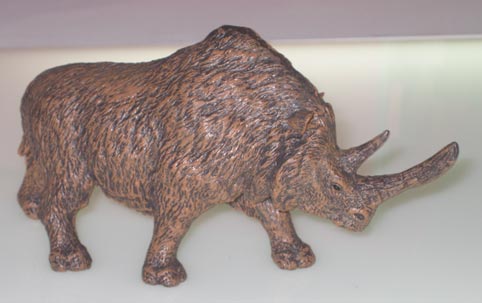Woolly Rhinoceros from Papo Shows Remarkable Detail
One of the most iconic prehistoric animals associated with the periods in geological history known as the Ice Ages is the Woolly Rhinoceros, a large, shaggy coated rhino that lived in Europe from approximately 500,000 years ago to around 10,000 years ago (Pleistocene to the beginning of the Holocene epochs). Papo, the French model and figure manufacturer, are about to introduce a new model of a Woolly Rhino into their highly acclaimed prehistoric animal model range. Having had the chance to view the model up close, it is clear that this new interpretation of Coelodonta antiquitatis elevates Woolly Rhino model making to a higher plain (or should that be higher plateau – see below).
Papo Woolly Rhinoceros
There were in fact several species of prehistoric rhinoceros that lived in Europe during the Pleistocene epoch, although the ancestors of the two-horned Woolly Rhino (Coelodonta antiquitatis) are believed to have migrated across the continent from Asia, having originally evolved on the Tibetan plateau. The fossilised remains of Woolly Rhinos have been found all across Europe, including southern Spain, however, no fossils have been found in Ireland or North America so it seems these grazers did not reach the American continent or indeed the Emerald Isle.
A number of very well-preserved carcases of these prehistoric mammals have been discovered in the higher latitudes of Russia during the spring thaw which leads to flooding in some areas and the subsequent erosion which exposes the animal remains. So numerous were these animal remains and so strange the preserved horns of these rhinos, that up until the late 19th Century many of the native people thought that the horns were actually the talons of a giant bird.
Coelodonta antiquitatis
The large, anterior horn (the one on the tip of the nose), of C. antiquitatis does not resemble the horn found on extant species of rhinoceros. The horn is much longer. the largest horns belonged to males and could grow to over two metres in length. Like modern rhinos, the two horns of Coelodonta were made of keratin (compressed, fibrous hair). The horns would have been very effective weapons used in self defence against attacks from creatures such as the European Lion (Cave Lion – Panthera genus), however, fossil evidence suggests that the anterior horn was not pointed but had a spatulate or keeled appearance. Scientists believe that the horn of the Woolly Rhino got its strange, keeled shape as the rhino grazed moving its head from side to side wearing the sides of the horn down.
The Woolly Rhino may have also used this horn to clear snow in order to find food. This prehistoric mammal, the largest of which could weigh up to two thousand kilogrammes could have had its own built-in snow plough.
The New Papo Woolly Rhino Model
Picture credit: Everything Dinosaur
A number of cave paintings depict Woolly Rhinos, the long shaggy coat and the short tail can be clearly made out in a number of the better preserved examples of Stone Age artwork. The very last Woolly Rhinos were to be found in Western Siberia. The demise of these large herbivores was probably due to the retreat of its glacial habitat and rapid climate change. As the Woolly Rhino had co-existed with both modern humans and Neanderthals for thousands of years it is unlikely that hunting caused its extinction.
Just as our ancestors depicted Woolly Rhinos with their cave art, so today’s model and figure manufacturers are keen to capture the beauty and power of this Ice Age icon. A number of models of Woolly Rhinos have been produced but the latest introduction to Papo’s “Les Dinosaures” range of prehistoric animal figures sets new standards. For example, not only is the French manufacturer’s new model extremely well crafted, the anterior horn on the model shows the spatulate, keeled shape suggesting that the design team have extensively researched the data on Woolly Rhinoceros fossils.
To view the range of Papo prehistoric animal models in stock at Everything Dinosaur: Papo “Les Dinosaures” Prehistoric Animal Figures.







I could not agree more with this article on Papo’s MAGNIFICENT Woolly Rhino. This figure is absolutely stunning, and I believe packed with scientific research. It is by far the most accurate and well sculpted figure of a Woolly Rhino. Congratulations to whoever the design team for Papo was on this one…WOW